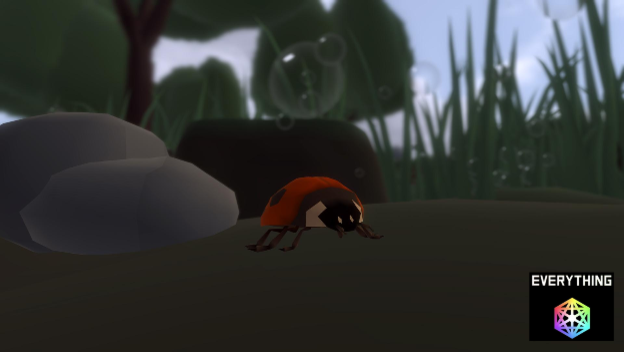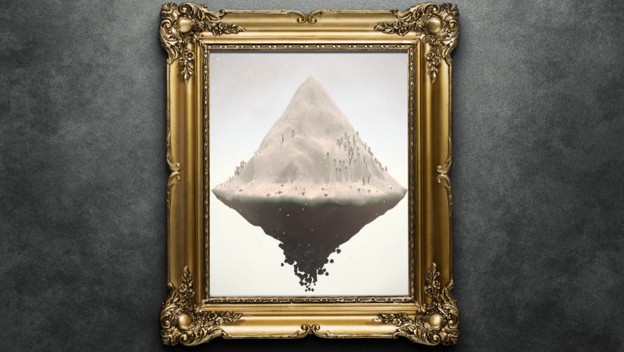Even without user input, or very minimal user input, I believe that games like Mountain can still be called video games. Video games, like art, are entirely subjective to the player. I may not like Mountain , I may find it boring and the message it sends convoluted and dry, but that doesn’t mean it is not a video game.
What is Mountain ? It’s a game by David O’Reilly in which the player is, well, a mountain. The mountain is floating in a white cloud amidst what appears to be space. Space is speckled with stars, astroids, and a version of the milky way. The mountain is slowly rotating and has a few trees. As the game progresses, there are occasional phrases at the top left of the screen that are seemingly random. Keys, when pressed, emit a soft melodious tone and can trigger phrases to appear. Eventually, random objects will fly into the mountain, like a pie, chair, and gramophone. The player can move these by clicking and holding, either putting them in different places on the mountain, or getting rid of them entirely. The end of the game seems to be entirely random as well, featuring a red dwarf star, a red arrow, and likely quite a few other surprises I haven’t seen yet. All endings, however, have music from the famous film 2001: A Space Odyssey and similar coloured flashes.
O’Reilly is coming out with a new game, this time called Everything. The trailer is about as confusing as the title, but seems to be drawing from the history of the Earth. There are spinning particles and later bacteria shaped objects that could represent the primordial ooze from which life on Earth began. Later, plants appear to grow and eventually become various creatures. If this game is to be anything like Mountain, then the trailer may be displaying the progression of the game itself. O’Reilly does mention that the player can play as anything, from the ladybug to the various trees. I admit, I am not entirely sure what such a mechanic might mean.
A video game, first and foremost, is art. Defining art is about as sticky as honey, however a definition I believe we can all agree with, is derived from Leo Tolstoy’s What is Art? For the sake of efficiency, I will attempt to paraphrase Tolstoy’s eloquent words on the subject. The definition of art lies squarely in the observer. In other words, art is subjective. If you are alone with an object (the “art”), completely unoccupied, with no evidence of the artist or other people (the audience) around you, and you experience a state of mind similar to that of the artist during the time of the object’s creation, then that object is an object of art (Tolstoy 214). The most important part of this feeling, is that you are so completely merged with the artist that it seems to you that the object was created by you, and that all that is expressed by the object, is just what you have been longing to express (215). Real art should invoke in you a conscious lack of distinction between yourself and the artist (216).

If all a video game has to do to be considered a video game is invoke an emotional response in the player similar to that of the artist, then I believe that Mountain and Everything should be considered video games. The user input in Mountain may be very limited and impossible to figure out without a lot of trial and error, but I believe each event in the game is just as heavy with meaning as when the player finally rings the second bell in Dark Souls, even if it is not entirely explained.
